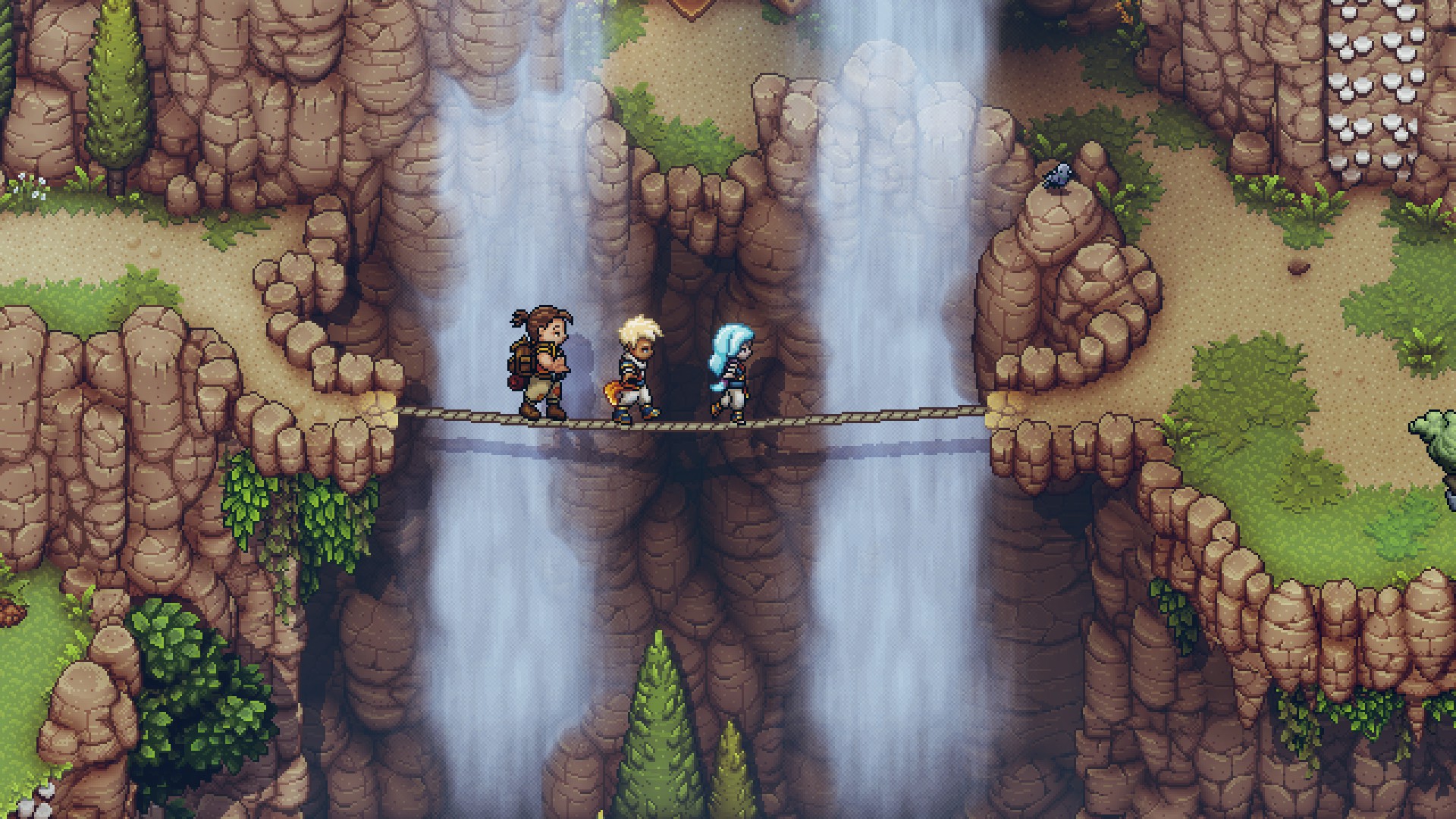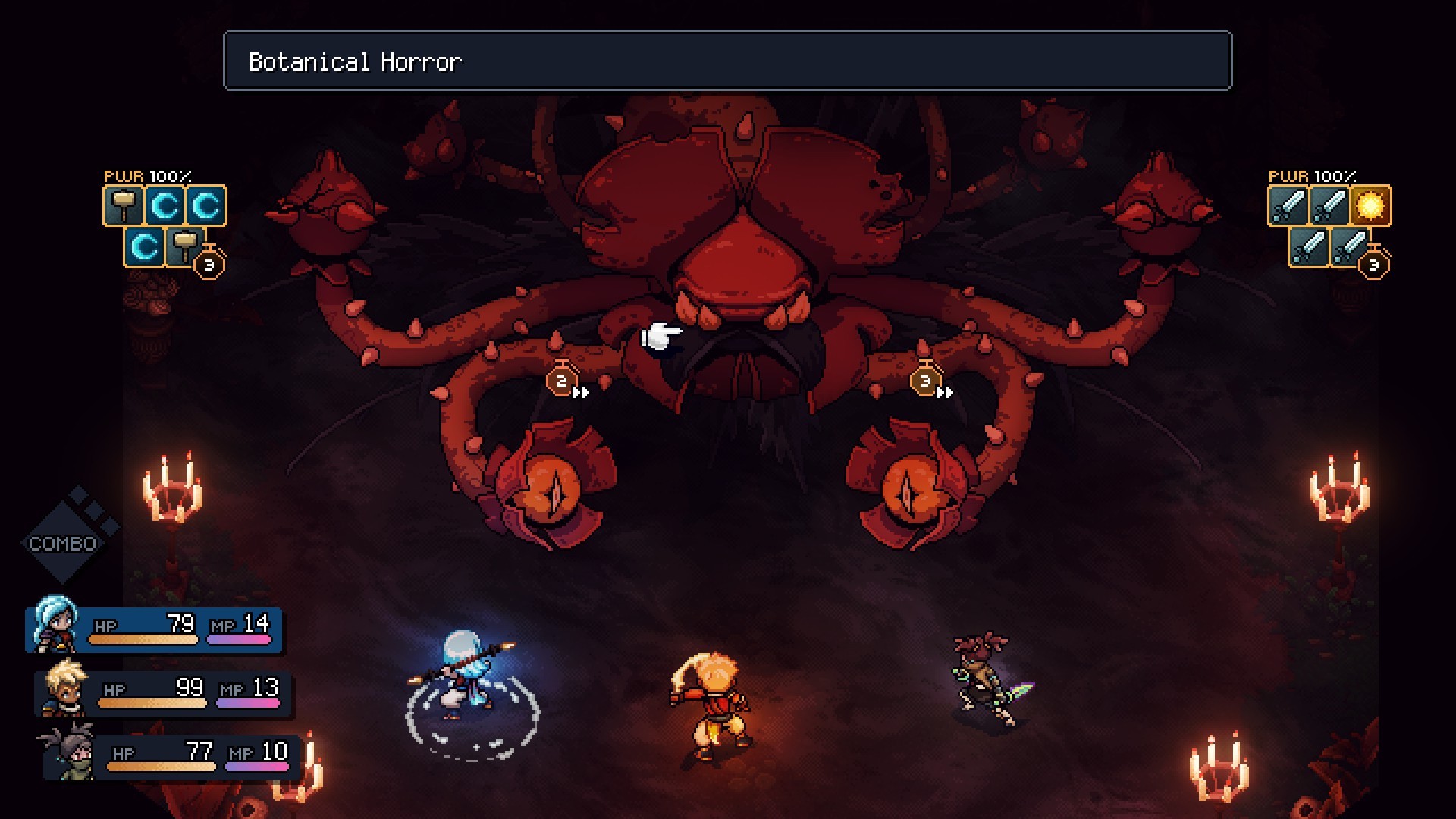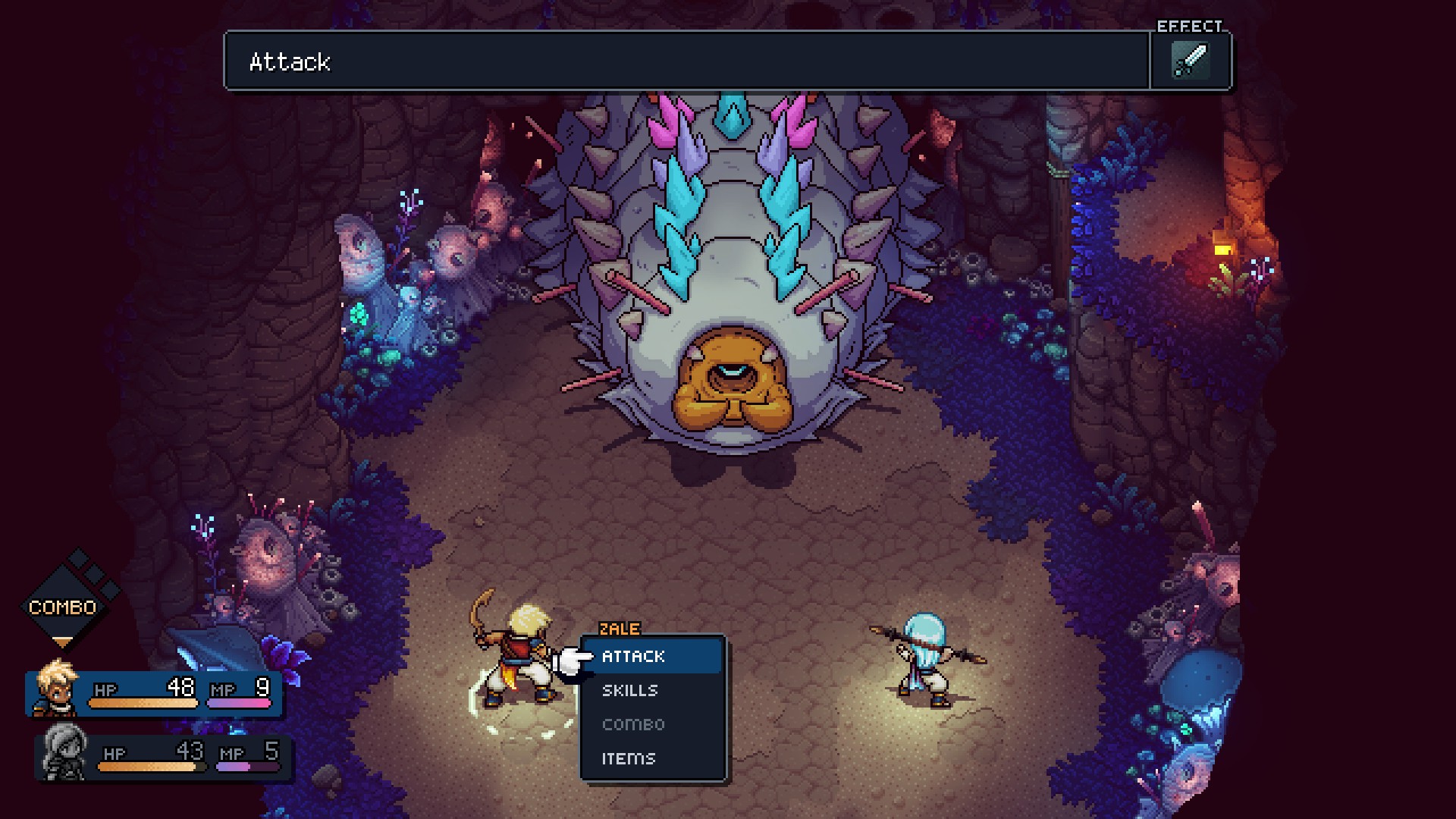GamesRadar+ Verdict
It's a joy and a relief to realise that Sabotage hasn't merely mimicked classic '90s JRPG, but committed to understanding what makes them tick. Its nostalgia is neither gratuitous nor cynical, instead working disparate references together with original ideas into a coherent whole. While it's a little disappointing to discover that there's isn't great depth to the turn-based battles and other systems, the immense quality and detail in the pixel art, soundtrack, location design, characters and plot ensure that Sea of Stars remains a stunning achievement to the end.
Pros
- +
Glorious pixel art and a delightful soundtrack
- +
Lots of well-judged callbacks to classic JRPGs
- +
An imaginative story with likeable characters
Cons
- -
A lack of depth and challenge in combat and puzzles
Why you can trust GamesRadar+
The two main characters of Sea of Stars are fairly unremarkable RPG heroes, but ideal companions for this ode to Japanese genre classics. From birth they're herded by fate and duty to become 'Solstice Warriors', yet even once they set out on world-saving business they're still buzzing with childlike excitement and wanderlust. With that, Sea of Stars captures the same youthful thirst for adventure that glued me to JRPGs some 30 years ago, when they made their first successful journeys West.
Release date: August 29, 2023
Platform(s): PC, PS5, PS4, Switch, Xbox Series X, Xbox One
Developer: In-house
Publisher: Sabotage Studio
From my western perspective at least, then, developer Sabotage Studios revives the spirit and emotional history of the genre here, displaying a nuanced appreciation of its craft. And above all, Sea of Stars burns with the sense of mystery and wonder that fuelled some of the best RPGs of old. Its world drips with prophecy and myth. Demons fester in deep lairs. Ancient shrines guard treasures destined for champions. You hear tales of a gargantuan serpent coiled around a mountain, kept asleep only by tuneful winds whistling through rocky tunnels. The Solstice Warriors, Valere and Zale, along with their effervescent mate Garl, are desperate to see these sights, to unlock legends, unleash magic. Just like you.
Links to the Past

As these travellers look forward, though, Sabotage certainly keeps a foot in the past, and lays the nostalgia on thick for the initiated. The game opens with a storyteller speaking to you directly, similar to the way the Shining Force games began. The soundtrack conjures flashes of Secret of Mana, Soul Blazer, and Wild Arms (some great pan pipes tunes). Your party runs in a single-file train that I'll always associate with Phantasy Star. A fishing mini-game resembles those in Breath of Fire III and 4, while a recurring boardgame has hints of the card games in Final Fantasies 8 and 9. There's some light town-building reminiscent of Suikoden, while vertically layered dungeons tip their hat to 2D Zeldas. Battles contain flavours of Chrono Trigger, Super Mario RPG, Vagrant Story, and Final Fantasy again.
Also, while the tone of Sea of Stars very much belongs in the '90s, the influences aren't limited to that decade. Some of the combat systems resemble Square Enix's own retro revivals, Bravely Default and Octopath Traveller. There are touches of Lost Odyssey, such as in the way characters auto-revive after a few turns when KO'd, while foraging and cooking recalls Zelda: Breath of the Wild as much as anything. I'm sure there's plenty more besides too.
Yet crucially, as much as Sea of Stars revels in excavating memories, this isn't cold, cynical nostalgia targeted to prick the ears of a demographic. Rather, it breathes with a curator's eye for coherence and a warmth that feels like snuggling into a comfy old coat. You can see it, in fact, in the sumptuous pixel art, with its rich palette, its expressive character animations, the parallax scrolling as you ascend from your home village to a magic school in the sky. And you can hear it with the catchy, almost-but-not-quite chip tune music that circulates through each location.
Dungeon Master

The sights and sounds come thick and fast too, since getting around the wilderness and dungeons in Sea of Stars is a briskly enjoyable affair. Your team are nimble little mountain goats, well versed in hopping over gaps, balancing across tightropes, and clambering up the kind of ledges that would have stumped heroes of generations past. And, whether inside or out, areas are built with an impossible, just so neatness. Switches and levers trigger retractable platforms and elevators. Rogue crystals unseal ancient doors when reunited with their intended pedestals. Less travelled paths host treasure chests but also ingredients you can pick then cook at a campfire to stuff your backpack with restoratives.
Monsters abound too, naturally, although far from random you'll run into them at deliberate intervals. Combat is as neat and tidy as the level design, with a handful of harmonious systems turning each confrontation into a minor puzzle. Within the turn-based structure, enemies unleash regular attacks or signal that they're winding up a more powerful move, and you can weaken or even cancel the latter if you hit them with the right kind of weapons or magic before it triggers. Unfortunately, magic is restrained by limited MP pools, but you can recharge MP with ordinary strikes, which also generate 'live mana' that can be absorbed to imbue your next attack with magic power (similar to BP in Bravely Default and Octopath Traveller). Rotating between attacks, live mana attacks and spells thus becomes essential.
There's also a more active angle to battles that can be equally as important, however. Pressing a button as your attack lands adds a little extra oomph to it, and likewise you can reduce incoming damage with a precisely timed block. Or, if you want to get the most out of Valere's 'moonerang' magic, say, which bounces a projectile from the Solstice Warrior to each enemy in turn, it's up to you to keep timing the deflections for as long as possible. If this all sounds a little intrusive, rest assured that you're not expected to hit all your cues. Sea of Stars is generous when it comes to difficulty, including against its magnificently drawn bosses, and even allows you to purchase relics that dial it down further.
Shallow Waters

Indeed, if anything, Sea of Stars remains a little too mild in its demands, prioritising clean simplicity over depth and challenge. For instance, it's rare for an RPG of this sort to have no status effects to worry about in battle, or buff and debuff abilities. Food items are limited to HP and MP recovery effects, then, so there's little strategy to considering the contents of your lunchbox, while infrequent levelling up only provides minor stat boosts, rather than evolving your characters' move sets, which dampens the reward potential of combat somewhat.
In a similar vein, dungeons rarely force you to stop and think for more than a few seconds, as switch throwing and block shoving puzzles refuse to bloom into anything potentially confounding (some optional end of game areas aside). You place a magic seashell on a magic altar, find a crown to place on a statue of a king, fight some monsters for a key, open a door, move on. The environments vary, the structures not so much. When you're not exploring, distractions such as fishing or the board game 'Wheels' reveal themselves to be fun but slight – not the sort of thing you can sink hours into – while each time the plot throws up a new problem, a friendly NPC immediately offers a solution, shuffling you forward to the next location.
True, adventure should be breathless at times, but isn't it also about earning your momentum and stopping to smell the flowers once in a while, unless they're the kind that could bite your head off? The first half of Sea of Stars can feel a little mono-paced, not least because travel on the overworld map means following a series of rail-road lines, and there's a dearth of side quests to make you appreciate the inner workings of each locale and its populace. By casting such a wide net, the game's features can begin to feel like a tasting menu, serving up morsels before clearing the plates for the next course.
Flight of Fantasy

Yet from around the halfway point, Sea of Stars harnesses a second wind that propels it right to the end. While the shallowness remains, the early sense of adventure is rekindled by an irresistible escalation of imagination and an endless supply of ideas both great and small. A tasting menu of an RPG it may be, but make no mistake this is a delicious, Michelin-starred tasting menu of an RPG.
For starters, the story really begins to go places, and with that comes greater freedom to traverse the world. The machinations you have to go through to reach the ultimate villain – the unfortunately named 'Fleshmancer' – send you to ever wilder places to meet ever wilder beings and accomplish ever wilder tasks. The script, a serviceable balance of jolly humour and apocalyptic portent for the most part, also starts to sing once further characters are introduced to your party. And dungeons, including one where you raise and lower water levels, and another whose bottom layer lies visibly unreachable beneath thick ice, become more fascinatingly intricate, albeit still quite straightforward to conquer.
Likewise, as your eye gets accustomed to the quality of the pixel art and threatens to tune it out, Sabotage raises the bar, committing to even more extraordinary sights. The autumnal reds of one wooded area, for instance, feel as gloriously fresh as an earlier area of outstanding natural beauty comprising cascading waterfalls and gleaming coral. The soundtrack, although perhaps overall not quite as memorable as that of a Suikoden or Secret of Mana, equally remains able to catch you off guard now and again. Following in the footsteps of Square and Enix way back when, Sea of Stars grasps the value of audio and visuals play in games of this sort, deploying splendid sights and sounds to drive you on.

Where Sea of Stars surpasses the old classics, however, is in its astonishing detail. Observe the way glowing flowers light the way in an underground cavern, for example, casting real-time shadows, or the change in musical arrangement as day slides into night. Perhaps take a moment to enjoy the animation on a giant stone head that agrees to spit you across the map if you enter its mouth. Or sit through the album's worth of tunes played by the pirate band in your local inn. You may even note that if you engage one of the pirates in conversation, the sound of their instrument drops from the mix for the duration.
The lack of depth across the mechanical parts of Sea of Stars thus eventually come to feel less relevant as another kind of depth emerges. This is the depth to which Sabotage has soaked itself in its genre of choice, and the depth of its commitment to the marvellously unexpected that spellbinds not only on the merits of past games but also on the merits of its own art and fiction. And at the same time, for this western player of '90s JRPGs, Sea of Stars most of all comes to feel like a big, affectionate thank you gift, acknowledging the designers at Square Soft, Enix, Capcom, Konami, Sega, Nintendo, and more – for the incredible sights and sounds, their boundless imagination and, of course, the adventure.
Sea of Stars was reviewed on PC, with code provided by the publisher.
More info
| Genre | RPG |
Jon Bailes is a freelance games critic, author and social theorist. After completing a PhD in European Studies, he first wrote about games in his book Ideology and the Virtual City, and has since gone on to write features, reviews, and analysis for Edge, Washington Post, Wired, The Guardian, and many other publications. His gaming tastes were forged by old arcade games such as R-Type and classic JRPGs like Phantasy Star. These days he’s especially interested in games that tell stories in interesting ways, from Dark Souls to Celeste, or anything that offers something a little different.



